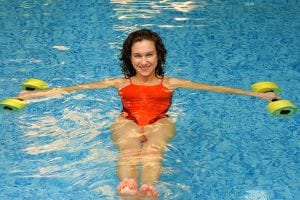
Pool physical therapy, also known as aquatic physical therapy, is a treatment option for chronic pain, fibromyalgia, rheumatoid arthritis, osteoarthritis and many other conditions. It can also help patients who have undergone joint replacement surgery.
How it Works
The therapy sessions take place in heated swimming pools, and the warm water can ease pain. The water also provides buoyancy and thus reduces the weight bearing load on the pelvis, lower back, and leg joints. If a patient is immersed up to their neck, the water supports 90 percent of their body’s weight. If the patient is standing in waist-deep water, the water supports 50 percent of their body’s weight.
The water also creates hydrostatic pressure that affects all the surfaces of an object submerged in the water. Hydrostatic pressure can reduce swelling and help support a limb or body. It can therefore help reduce pain and improve a patient’s range of motion. The water pressure also improves circulation, especially to the extremities. As a result, more blood can reach wounds and speed up healing.
Water also has sufficient viscosity to provide resistance when the patient moves through it. A patient can therefore preform strength-training exercises in the water.

What to Expect
Pool physical therapy can take many forms, and the exact form will depend on what a patient needs. A patient being treated for balance problems will receive a different treatment than someone undergoing treatment for chronic pain.
The therapist may also have the patient use various types of equipment during their session. For example, there are stationary bicycles and treadmills that can be used underwater. You can use them just like the conventional models. You may also use noodles, kickboards, flotation gear, or weights.
You will have to wear a swimsuit or clothing that can get wet and allow freedom of movement. You should also bring a towel, a cover-up, protective footwear, and a bottle of water to keep yourself hydrated.
Candidates
Patients with certain physical problems are not good candidates for pool physical therapy. They include the following:
- Open sores or wounds
- High fever
- Uncontrolled seizure disorder
- Incontinence
- Serious respiratory problems
- Allergy to chlorine or bromine
- Hepatitis A
The Burkendo Method?
The Burkendo Method is a type of physical therapy that was developed by Igor Burkendo, a professor of sports medicine from the Soviet Union. It is often used to rehabilitate patients with sports injuries. Clients perform exercises to improve their strength, balance, stamina, speed, coordination, and flexibility.
At the beginning of their treatment, clients will perform their exercises in the water. As their condition improves, they will gradually start performing more and more exercises on land.
Aqua Running
Aqua running, also called aqua jogging or deep-water running, is just like it sounds. The patient wears a flotation belt to keep their head above water while they run. This allows you to enjoy the cardiovascular benefits of running without harming their joints.




